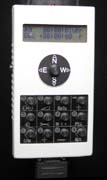When I moved to my semi-rural location in early 2004 and planned my Observatory, I had to decide whether to install my trusty LX90, or go upmarket. It wasn't a difficult decision! The dark skies and open aspect justifed higher quality equipment. I definitely wanted a German Equatorial Mount - easier to balance for Astrophotography/Imaging, and able to carry a variety of telescopes. But choosing a 'mount for life' was not easy.
The most sought after mounts were mainly from the USA, some with a long waiting list, and an inflated price in the UK even with a weak US dollar. I had a couple of mounts on my short list, one of which was the G41, but I hadn't seen one 'in the metal'. Fortunately there was one on display at the London Astrofest in February 2004, and I settled on the Observatory model with Pulsar controller. This mount is well engineered with large drive gears and substantial carrying capacity of 35 Kg, made in Hungary with its own dedicated microstepping drive system which can slew up to 7 degrees per second using an inbuilt 12 to 24 volt converter. Full details on the Gemini Web Site.
I ordered direct from Gemini, and the mount and tripod duly arrived on Saturday 17th. April 2004 . And earlier in the week my TMB 105 refractor was returned from Bray Imaging where it had been undergoing modifications to improve the alignment of the tube assembly. As it happened a group of us had booked a few days at Kielder in darkest Northumberland. So before even installing the mount in the Observatory I was able to try it out at a truly dark site. With an excellent result on an image of M65/66.
With the mount eventually installed in the observatory, I settled down to discover its full potential. There were a few software 'bugs' to be sorted, and unfortunately at one point a fault developed in the controller which had to be replaced. But András Dan of Gemini was unfailingly helpful, and even when I wrongly (and strongly!) complained about poor GOTOs he helped me to solve the problem.
The supplied polar 'scope enables a very accurate polar alignment, and the Periodic Error of the mount is small (better than +/- 6 arc-seconds). The PEC (Periodic Error Control) feature is easy to program since the worm period with the large (432 tooth) drive gears is only a little over 3 minutes. I regularly obtain satisfactory unguided images of 3 minutes or more at 2000 mm focal length, and much longer at shorter focal lengths. The controller has an autoguider input, but at the time of writing (Early December 2004) I have yet to fully explore this feature.
POSTSCRIPT By 2009 I had been autoguiding regularly for some time with my modified web camera, and when I upgraded to a dual chip SBIG camera it became even easier to autoguide, so I hardly ever used PEC.
It's worth mentioning the solution to the inaccurate GOTOs. They had been pretty good, but in late November 2004 I recollimated my Mirage tube, and at the same time installed the latest version of the Pulsar software. The GOTOs became very disappointing, at times more than a degree off. I blamed the software. But the solution was to shim the Mirage dovetail to realign the optical axis of the telescope so that it was orthogonal, i.e. at right angles to the Declination axis of the mount. The shims available (bits of tin cans!!) did not give a perfect alignment, yet now the GOTOs are within 5 arc minutes over the whole sky, and if I realign on a star near my target, are within 1 or 2 arc minutes. Impressive!!!
|
The handset has a nifty joystick controller, which is used to move the mount in any of the user programmable speed ranges, and also to navigate through the submenus of the various control buttons. The system is very easy to use once familiarised with the various functions. Supplied databases are Stars, Messier Objects and the full NGC list. Sections of memory are also available for user objects, but there is insufficient memory for the full IC catalogue, and no facility for internal calculation of solar system orbits to observe Asteroids, Planets, Comets etc. There is a link on the Gemini site to preset databases for the Sun and Planets, and the controller is fully compatible with many planetarium programs - I use Skymap regularly with excellent results. All the databases can be edited, but this must be done 'off line' on a computer - it's not possible to enter objects directly using the handset. |
 |
|
I have well loaded the mount with my Mirage, Helios solar scope and AT1010 on a Guide Star frame, and it is rock steady and smooth in operation. The clutches can be set so as not to slip in use, yet allow movement if I bump into the mount in the dark - this protects the worm drives from damage. The mount happily tracks across the meridian, and there are programmable limits to prevent mount clashes. |